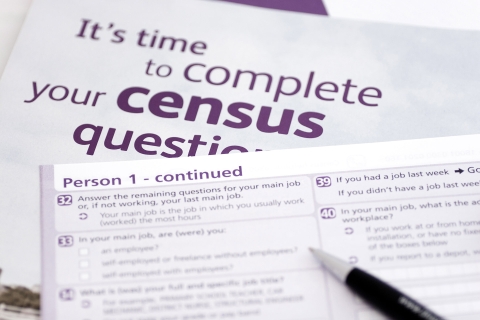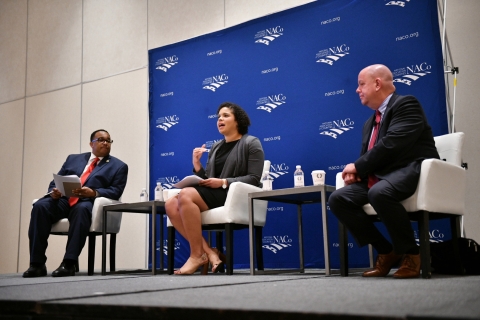Make it Count: Counties and Census 2020
Upcoming Events
Related News
Introduction
With nearly a trillion dollars in federal funding apportioned each year based on Census results, an accurate, complete count is crucial to county governments and their residents.1 Funding for health care, economic development, infrastructure, education and other critical local services is informed by Census results. County governments must be prepared to navigate challenges in achieving a complete Census count in 2020, including concerns about data security and the impacts of moving to an online form for populations without adequate internet and technology access.
Since early 2019, many counties around the country have been hard at work preparing for the 2020 Census by organizing local Complete Count Committees, coordinating with other governmental partners, and developing relationships with community organizations.
Many other counties are just beginning to organize their Complete Count Committee and develop their strategy for 2020. Like a runner preparing for a marathon in eight weeks instead of the prescribed 12 to 20 weeks of training, this accelerated timetable creates additional challenges, but these challenges can be managed and mitigated. This brief provides strategies and insights on two key steps that any county can take to start organizing their Complete Count Committee to meet the unique needs of their community and establish partnerships with trusted community partners.
This brief is made possible through the generous support of The Annie E. CaseyFoundation and the New Venture Fund and we thank them for their support; however, findings and conclusions presented in this report are those of the author(s) alone, and do not necessarily reflect the opinions of these organizations.

|
Step 1: Organize Your Complete Count Committee with the Right Staff and Structure
Most Complete Count Committees are comprised of a strong mix of government, business, civic and community stakeholders, but many of them do not have dedicated staff to implement their strategy and lead their operations on a daily basis. Finding the resources to staff a Complete Count Committee is not easy during a time when many county governments have limited budgetary flexibility,2 but the impact for those counties who do have dedicated staffing is tangible.
|
The Austin-Travis County, Texas Complete Count Committee is being led by its first ever, full-time Census Program Manager. This position is jointly funded via $50,000 from Travis County (through the use of one-time funds), and the City of Austin (as part of its annual budget process). |
Collaborating to fund the Program Manager position not only allowed the county and city to deepen an already strong working relationship, but it allows the Committee to operate with an attention detail and level of urgency that is hard to find when the Census is just one part of an executive staff member’s day to day responsibilities. It also allows the region to take a comprehensive approach to outreach, and leverage economies of scale. The Austin-Travis County Program Manager has developed a communications and outreach strategy and is leading an effort to raise $1M with a regional partner to execute that strategy by leveraging $200,000 investments by both Travis County and the City of Austin. |
Yet, having dedicated staff is simply not possible for many counties. In those cases, it is even more important that the Complete Count Committee include the right mix of staff from the county executive office, other key county departments, nonprofit and philanthropic partners, and community members.
|
The formation of the Erie County, N.Y. Complete Count Committee began in April 2019 with an Executive Order signed by County Executive Marc Poloncarz. |
The Committee is co-chaired by representatives from key internal departments like the Department of Environment and Planning, who were involved in the Local Update of Census Addresses and bring valuable mapping capabilities; governmental partners like the City of Buffalo; and external partners like the Community Foundation for Greater Buffalo, a key resource for fundraising efforts. Though the Committee has more than 70 members, strategic decisions are made by an informal “Executive Committee” comprised of a Community Liaison from the County Executive’s Office, the co-chairs, the Director of Buffalo and Erie County Public Library, staff from the Community Foundation for Greater Buffalo and the director of Buffalo Area Census Office. The “Executive Committee”, which meets monthly and communicates regularly, provides a replicable structure that fosters strong cross-sector working relationships. The model allows Erie County to serve as a convener and coordinator without having all the operational responsibilities for the area’s Census outreach. |
|
Arlington County, Va. organized their Complete Count Committee with a focus on finding individual community members, not just organizations, who represent the county’s diversity across a number of characteristics, including race, neighborhood, and incomes. |
Census efforts in the county are led by an Assistant County Manager for Communications and Public Engagement, and a Principle Planner and Demographer for the county. Both are executive staff whose primary duties naturally align with the day to day needs of supporting the Committee. And an additional four staff members spend approximately 20 percent of their time supporting the Census. The 42-member Committee includes 30 community members, county board and school board liaisons, and nine liaisons for key departments including fire, police, parks and recreation and libraries. The Committee also operates with only four subcommittees focused on communications, donation support, hard to reach populations, and partnerships. |
|
|
Step 2: Identify and Target Your Most Hard to Count Communities with Trusted Partners
Regardless of how your Complete Count Committee is organized, building effective relationships in hard to reach communities will be necessary to ensure a complete and accurate count. Establishing these relationships, however, is sometimes easier said than done. For example, research conducting by the National Association of Latino Elected and Appointed Officials Educational Fund found that elected officials were among the least trusted sources of information for Latinx participation, while healthcare providers, community organizations, and educators were highly trusted messengers3. This doesn’t mean that local officials shouldn’t lead or be highly engaged in driving participating efforts, but it is important to understand where certain communities are and who can best connect with them.
Based on the unique needs of your community, it will be important to identify the trusted messengers in your hard to reach communities and build relationships with them by supporting ongoing outreach activities or educating them on the importance of a complete count.
|
In Cooke County, Texas, a rural county with a population of 40,000, there is not a strong tradition of civic engagement between the county’s Hispanic community and local government, including during the 2010 Census. At almost 20 percent of its population, garnering stronger participation from the Hispanic community is a priority for Cooke County Judge Jason Brinkley |
The county has focused its outreach efforts on working with churches with large Hispanic congregations and the Gainesville Independent School District, the only one of three local school districts with a majority Hispanic student population. Understanding that it will take time to build these relationships, the county’s outreach message has emphasized the potential loss of funding for schools and community resources, a strategy that NALEO’s research also identified as effective for Latinx communities. |
|
With a population of more than 2 million, the King County, Wash. Regional Census Committee has a targeted focus on developing outreach and engagement strategies in South King County because it is home to the highest concentration of historically undercounted communities in hard-to-count census tracts |
King County, in partnership with the Cities of Seattle, Bellevue, Kirkland, and Redmond, along with the Seattle Foundation, contributed dollars the Regional Census Fund (RCF). RCF has roughly $1.2 million in funding for grants to community organizations to mobilize hard to count communities over a spring and fall cycle. The first round saw 21 organizations granted $710,000 to focus on outreach and engagement efforts within King County and the second round of applications is currently in the review process. County officials suggest that the best communication strategies for hard to reach communities are coming from community organizations when they apply for funding. Rather than county government developing its own outreach strategy, members of these unique communities are telling King County the best strategies for communication and what type of resources are required. The City of Seattle and King County identified Pacific Islanders, Latinx and African American populations, and the funding is a priority to organizations working in those communities. |
|
Even without providing grants, counties can support community organizations simply through training on Census messaging and providing logistical support for organizations that are already promoting outreach in hard to reach communities. |
Without a large pool of funding to award to community organizations, Arlington County has empowered more than 160 community organizations to serve as ambassadors to communicate the importance of the Census within their communities. Inspired by the local chapter of Asian and Pacific Islander America Votes and other partners who developed their own independent Complete Count Committee for Travis County’s Asian community, Travis County is supporting the development of similar Complete Count Committees for the Latinx and African American communities. King County is working with its municipal partners to ensure that community organizations can regularly access space in community centers, libraries and other local government facilities for public meetings and other preparation activities. |
Conclusion
Whether your county has been preparing for the 2020 Census for over a year or is just beginning to organize a Complete Count Committee, there are important steps that can be taken to get ready. Making sure that your Complete Count Committee is organized and structured based on the resources and needs of your community, and identifying your hard to count communities and building partnerships with trusted messengers in those communities are two important steps your county can implement to run a strong race from start to finish.

|
Cook County, Ill. Commissioner Stanley Moore, Beth Lynk of the Leadership Conference, and Tim Olson of the US Census Bureau speak about the county role in Census 2020 administration at the 2019 NACO Annual Conference. Photo by NACo.
Acknowledgments
This brief is made possible through the generous support of The Annie E. CaseyFoundation and the New Venture Fund and we thank them for their support; however, findings and conclusions presented in this report are those of the author(s) alone, and do not necessarily reflect the opinions of these organizations. Special thanks to the following individuals for sharing their time and expertise:
- Travis County, Texas – John Lawler, Census Program Manager
- Erie County, N.Y. – Jason Hurley, Community Liaison
- Arlington County, Va. – Bryna Helfer, Assistant County Manager, Communications and Public Engagement
- Cooke County, Texas – Judge Jason Brinkley, County Judge
- King County, Wash. – Heidi Park, Census External Partnerships Program Manager
